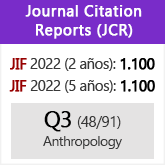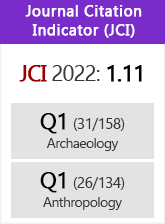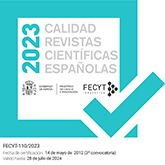Redefiniendo el registro material. Implicaciones recientes desde la arqueología del paisaje anglosajona
DOI:
https://doi.org/10.3989/tp.2007.v64.i1.93Palabras clave:
Teoría arqueológica, Arqueología del Paisaje, Registro arqueológico, Dimensión espacial, HistoriografíaResumen
Tras examinar brevemente la evolución en el ámbito anglosajón de las definiciones de registro arqueológico, así como del proceso por el cual se va conceptualizando lo espacial en la disciplina, se argumenta que el paisaje se concibe como otra manera de ampliar las definiciones manejadas de registro. Rastreados ambos procesos se analiza, tras concretar algunos de sus referentes teóricos, qué es lo que actualmente se entiende en Arqueología por paisaje, así como la manera en que se está abordando. De esta forma se concretan y valoran sus singularidades, se rastrean algunas de las influencias que han llevado a plantear el problema del paisaje y se evalúan las repercusiones que sus afirmaciones suponen para el estudio del pasado en Arqueología.
Descargas
Citas
Andrews, G. y THOMAS, R. 1995: “The management of Archaeological Projects. Theory and practice in the UK”. En M. A. Cooper, A. Firth, J. Carman y D. Wheatley (eds.): Managing Archaeology. Routledge, London- New York.
Anschuetz, K. F.; Wilshusen, R. H. y SCHEICK, C. L. 2001: “An Archaeology of Landscapes: Perspectives and Directions”. Journal of Archaeological Research 9 (2): 157-211. doi:10.1023/A:1016621326415
Ashmore, W. 2002: “‘Decisions and Dispositions’: Socializing Spatial Archaeology”. American Anthropologist 104 (4): 1172-1183. doi:10.1525/aa.2002.104.4.1172
Barrett, J. C. 1994: Fragments from Antiquity: An archaeology of social life in Britain, 2900-1200 BC. Blackwell, Oxford.
Barrett, J. C. 2002: “Agency, the Duality of Structure, and the Problem of the Archaeological Record”. En I. Hodder (ed.): Archaeological Theory Today. Polity Press. Cambridge.
Barrett, J. C.; Bradley, R. y HALL, M. (eds.) 1991: Landscape, Monuments and Society. The Prehistory of Cranborne Chase. Cambridge University Press. Cambridge.
Bauer, A. A. 2002: “Is what you see all you get? Recognizing meaning in archaeology”. Journal of Social Archaeology 2 (1): 37-52. doi:10.1177/1469605302002001596
Bender, B. 1992: “Theorising Landscape, and the prehistoric Landscape of Stonehenge”. Man 27: 735-755. doi:10.2307/2804172
Bender, B. 1993a: “Landscape-Meaning and Action”. En B. Bender (ed.): Landscape. Politics and Perspectives. Berg Publishers. Province/Oxford.
Bender, B. 1993b: “Stonehenge-Contested Landscapes (Medieval to Present-Day)”. En B. Bender (ed.): Landscape. Politics and Perspectives. Berg Publishers. Province/ Oxford.
Bender, B. 2001: “Landscapes on-the-move”. Journal of Social Archaeology 1 (1): 75-89.
Bender, B. 2002: “Time and Landscape”. Current Anthropology 43 (Supplement): 103-112. doi:10.1086/339561
Bender, B. (ed.) 1998: Stonehenge: Making Space. Berg. Oxford-New York
Binford, L. R. 1965: “Archaeological Systematics and the Study of Culture Process”. American Antiquity 31: 203-210. doi:10.2307/2693985
Binford, L. R. 1982: “The Archaeology of Place”. Journal of Anthropological Archaeology 1: 5-31. doi:10.1016/0278-4165(82)90006-X
Bintliff, J. (ed.) 1995: The Annales School and Archaeology. Leicester University Press. London-New York.
Bradley, R. 1989: “Darkness and light in the design of megalithic tombs”. Oxford Journal of Archaeology 8: 251-259. doi:10.1111/j.1468-0092.1989.tb00205.x
Bradley, R. 1990: “Rock Art and the Perception of Landscape”. Cambridge Archaeological Journal 1 (1): 77-101.
Bradley, R. 1998: The significance of monuments: on the shaping of human experience in Neolithic and Bronze Age Europe. Routledge. London-New York.
Bradley, R. 2000: An Archaeology of Natural Places. Routledge. London-New York.
Brothwell, D. y HIGGS, E. (comps.) 1980: Ciencia en Arqueología. Fondo de Cultura Económica. Madrid.
Butzer, K. W. 1989: Arqueología-Una ecología del hombre: Método y teoría para un enfoque contextual. Bellaterra. Barcelona.
Cabrera Acosta, M. Á. 2001: Historia, lenguaje y teoría de la sociedad. Cátedra. Madrid.
Cabrera Acosta, M. Á. 2004: Postsocial History: An Introduction. Rowman and Littlefield. Lanham.
Campillo Meseguer, A. 1985: Adiós al progreso. Una meditación sobre la Historia. Anagrama. Barcelona.
Casanova Ruiz, J. 2003: La historia social y los historiadores ¿Cenicienta o princesa? Crítica. Barcelona.
Clarke, D. L. 1984: Arqueología Analítica. Bellaterra. Barcelona.
Cobas Fernández, I. y PRIETO MARTÍNEZ, M. I. 1998: “Defining social and symbolic changes from the Bronze Age to the Iron Age through operational sequences in NW Iberian pottery”. En M. Sarah y M. Vidale (eds.): Craft specialization: Operational sequences and beyond. Papers from the EAA Third Annual Meeting at Ravenna 1997. Volume IV. B.A.R., International Series 720. Oxford. COLOMER i SOLSONA, E.; GONZÁLEZ MARCÉN, P.; MONTÓN SUBÍAS, S. y PICAZO GURINA, M. (comps.) 1999: Arqueología y teoría feminista. Estudios sobre mujeres y cultura material en arqueología. Icaria. Barcelona.
Criado Boado, F. 1991: “Construcción social del espacio y reconstrucción arqueológica del paisaje”. Boletín de Antropología Americana 24: 7-29.
Criado Boado, F. 1993a: “Visibilidad e interpretación del registro arqueológico”. Trabajos de Prehistoria 50: 39-56.
Criado Boado, F. 1993b: “Límites y posibilidades de la arqueología del paisaje”. Spal 2: 9-55.
Criado Boado, F. 1999: Del terreno al espacio: Planteamientos y perspectivas para la arqueología del paisaje. Cuadernos de Arqueología y Patrimonio 6. LAFC. Santiago de Compostela.
Cummings, V. y WHITTLE, A. 2003: “Tombs with a view: landscape, monuments and trees”. Antiquity 77 (296): 255-266.
Daniels, S. y COSGROVE, D. E. 2000: “Introduction: iconography and landscape”. En D. E. Cosgrove y S. Daniels (eds.): The Iconography of Landscape. Essays on the Symbolic Representation, Design and Use of Past Environments. Cambridge University Press. Cambridge.
Darvill, T. 1997: “Neolithic landscapes: Identity and definition”. En P. Topping (ed.): Neolithic Landscapes: Neolithic Studies Group Seminar Papers 2. Oxbow. Oxford.
Darvill, T.; Gerrard, C. y STARTIN, B. 1993: “Identifying and protecting historic landscapes”. Antiquity 67: 563-574.
Dyson-Hudson, R. y SMITH, E. A. 1983: “Territorialidad humana: una reconsideración ecológica”. En M. J. Buxó Rey (ed.): Cultura y ecología en las sociedades primitivas. Mitre. Barcelona.
Edmonds, M. 1999: Ancestral Geographies of the Neolithic: Landscapes, monuments and memory. Routledge. London-New York.
Evans, C.; Pollard, J. y KNIGHT, M. 1999: “Life in woods: tree-throws, ‘settlement’ and forest cognition”. Oxford Journal of Archaeology 18 (3): 241-254. doi:10.1111/1468-0092.00081
García Ramón, M. D. (ed.) 1985: Teoría y método en la geografía humana anglosajona. Ariel. Barcelona.
Giddens, A. 1998: La Constitución de la Sociedad. Bases para la teoría de la estructuración. Amorrortu. Buenos Aires.
Haraway, D. J. 1995: Ciencia, cyborgs y mujeres. La reivindicación de la naturaleza. Cátedra. Madrid.
Hawkes, C. 1954: “Archaeological theory and method: some suggestions from the Old World”. American Anthropologist 56: 155-168. doi:10.1525/aa.1954.56.2.02a00020
Hernando Gonzalo, A. 1999: “El espacio no es necesariamente un lugar: en torno al concepto de espacio y a sus implicaciones en el estudio de la prehistoria”. Arqueología Espacial 21: 7-27.
Hirsch, E. 1995: “Introduction. Landscape: Between place and space”. En E. Hirsch y M. O’Hanlon (eds.): The anthropology of Landscape. Perspectives on place and space. Clarendon Press. Oxford.
Hitchner, B. 1994: “The merits and challenges of an Annaliste approach to archaeology”. Journal of Roman Archaeology 7: 408-417.
Hodder, I. 1982: Symbols in Action. Ethnoarchaeological Studies of Material Culture. Cambridge University Press. Cambridge.
Hodder, I. 1997: “‘Always momentary, fluid and flexible’: towards a reflexive excavation methodology”. Antiquity 91: 691-700.
Hodder, I. (ed.) 2002: Archaeological Theory Today. Polity Press. Cambridge.
Holtorf, C. y KARLSSON, H. (eds.) 2000: Philosophy and Archaeological practice. Perspectives for the 21st Century. Bricoleur Press. Göteborg.
Iggers, G. G. 1995: La Ciencia histórica en el siglo XX. Las tendencias actuales. Una visión panorámica y crítica del debate internacional. Labor. Barcelona.
Ingold, T. 1993: “The temporality of the landscape”. World Archaeology 25 (2): 152-174.
Ingold, T. 1997: “The picture is not the terrain. Maps, paintings and the dwelt-in world”. Archaeological Dialogues 4 (1): 29-31.
Johnson, M. 2000: Teoría arqueológica. Una introducción. Ariel. Barcelona.
Johnston, R. 1998: “Approaches to the perception of landscape. Philosophy, theory, methodology”. Archaeological Dialogues 5 (1): 54-68.
Kopytoff, I. 1991: “La biografía cultural de las cosas: la mercantilización como proceso”. En A. Appadurai (ed.): La vida social de las cosas. Perspectiva cultural de las mercancías. Grijalbo. México.
Kvamme, K. L. 1999: “Recent Directions and Developments in Geographical Information Systems”. Journal of Archaeological Research 7 (2): 153-201.
Lemaire, T. 1997: “Archaeology between the invention and the destruction of the landscape”. Archaeological Dialogues 4 (1): 5-21.
Llobera, M. 1995: “Exploring the topography of mind: GIS, social space and archaeology”. Antiquity 70: 612- 622.
Llobera, M. 2001: “Building Past Landscape Perception With GIS: Understanding Topographic Prominence”. Journal of Archaeological Science 28 (9): 1005-1014. doi:10.1006/jasc.2001.0720
Llobera, M. 2003: “Extending GIS-based visual analysis: the concept of visualscapes”. Int. J. Geographical Information Science 17 (1): 25-48. doi:10.1080/713811741
Lyotard, J. F. 1995: La posmodernidad (explicada a los niños). Gedisa. Barcelona.
Olwig, K. R. 1993: “Sexual Cosmology: Nation and Landscape at the Conceptual Interstices of Nature and Culture; or What does Landscape Really Mean?”. En B. Bender (ed.): Landscape. Politics and Perspectives. Berg Publishers. Province/Oxford.
Orejas, A. 1995: Del ‘marco geográfico’ a la arqueología del paisaje. La aportación de la fotografía aérea. CSIC. Madrid.
Ortega Valcárcel, J. 2000: Los horizontes de la geografía. Teoría de la geografía. Ariel. Barcelona.
Parker Pearson, M. y RICHARDS, C. (eds.) 1999: Architecture and order: approaches to social space. Routledge. London-New York.
Patrik, L. E. 2000: “Is There an Archaeological Record?”. En J. Thomas (ed.): Interpretive Archaeology. A Reader. Leicester University Press. London-New York.
REDMAN, Ch. L. 1990: Los orígenes de la civilización. Desde los primeros agricultores hasta la sociedad urbana en el Próximo Oriente. Crítica. Barcelona.
Relph, E. 1983: Place and placelessness. Pion. London.
Richards, J. 1990: The Stonehenge Environs Project. English Heritage. London.
Roskams, S. 2003: Teoría y práctica de la excavación. Crítica. Barcelona.
Ruiz Zapatero, G. 1998: “Fragmentos del pasado: la presentación de sitios arqueológicos y la función social de la arqueología”. En P. González Marcén (ed.): Arqueología i ensenyament, Treaballs d’Arqueologia. Barcelona.
Santos Estévez, M. y CRIADO BOADO, F. 1998: “Espacios rupestres: del panel al paisaje”. Arqueología Espacial 19-20: 579-595.
Scarre, C. 2002: “Introduction: situating monuments. The dialogue between built form and landform in Atlantic Europe”. En C. Scarre (ed.): Monuments and Landscape in Atlantic Europe: Perception and Society during the Neolithic and Early Bronze Age, Routledge. London-New York.
Scott, J. W. 1999: Gender and the Politics of History. Revised Edition. Columbia University Press. New York
Shanks, M. y TILLEY, C. 1987: Re-Constructing Archaeology: Theory and Practice. University Press. Cambridge.
Stoddart, S. 1997: “GIS: a useful research technique, not an end in itself”. Archaeological Dialogues 4 (1): 65-70.
Thomas, J. 1993: “The politics of Vision and the Archaeologies of Landscape”. En B. Bender (ed.): Landscape. Politics and Perspectives. Berg Publishers. Province/ Oxford.
Thomas, J. 1998: “The socio-semiotics of material culture”. Journal of Material Culture 3 (1): 97-108. doi:10.1177/135918359800300105
Thomas, J. 2002: “Archaeologies of Place and Landscape”. En I. Hodder (ed.): Archaeological Theory Today. Polity Press. Cambridge.
Thomas, J. 2003: Understanding the Neolithic. A revised second edition of Rethinking the Neolithic. Routledge. London- New York.
Tilley, C. 1994: A Phenomenology of Landscape: Places, Paths, and Monuments. Berg. Oxford.
Tilley, C. 1996: “The powers of rocks: topography and monument construction on Bodmin Moor”. World Archaeology 28 (2): 161-176.
Trigger, B. 1992: Historia del pensamiento arqueológico. Crítica. Barcelona.
Tringham, R. 2000: “Lugares con género en la Prehistoria”. Arqueología Espacial 22: 187-221.
Tuan, Y.F. 1974: “Space and Place: Humanistic Perspective”. Progress in Geography 6: 211-252.
Unwin, T. 1995: El lugar de la geografía. Cátedra, Madrid.
Wainwright, G. J. 1989: “The management of the English landscape”. En H. Cleere (ed.): Archaeological Heritage Management in the Modern World. Unwin Hyman. London.
Wansleeben, M. y VERHART, L. 1997: “Geographical Information Systems. Methodical progress and theoretical decline?” Archaeological Dialogues 4 (1): 53-64.
Watson, A. 2001: “Composing Avebury”. World Archaeology 33 (2): 296–314. doi:10.1080/00438240120079307
Watson, P. J.; LeBlanc, S. A. y REDMAN, C. L. 1974: El método científico en arqueología. Alianza. Madrid.
Whittle, A. 1997: “Moving on and moving around: Neolithic settlement mobility”. En P. Topping (ed.): Neolithic Landscapes: Neolithic Studies Group Seminar Papers 2. Oxbow. Oxford.
Williams, R. 2001: El campo y la ciudad. Paidós, Barcelona.
Wylie, A. 1999: “La interacción entre las limitaciones de la evidencia y los intereses políticos: investigaciones recientes sobre el género”. En L. Colomer et al. (eds.): Arqueología y teoría feminista. Estudios sobre mujeres y cultura material en arqueología. Icaria. Barcelona.
Yentsch, A. y BEAUDRY, M. C. 2002: “American Material Culture in Mind, Thought, and Deed”. En I. Hodder (ed.): Archaeological Theory Today. Polito Press. Cambridge.
Yesner, D. R. 1983: “Cazadores-Recolectores marítimos: ecología y prehistoria”. En M. J. Buxó Rey (ed.): Cultura y ecología en las sociedades primitivas. Mitre. Barcelona.
Descargas
Publicado
Cómo citar
Número
Sección
Licencia
Derechos de autor 2007 Consejo Superior de Investigaciones Científicas (CSIC)

Esta obra está bajo una licencia internacional Creative Commons Atribución 4.0.
© CSIC. Los originales publicados en las ediciones impresa y electrónica de esta Revista son propiedad del Consejo Superior de Investigaciones Científicas, siendo necesario citar la procedencia en cualquier reproducción parcial o total.Salvo indicación contraria, todos los contenidos de la edición electrónica se distribuyen bajo una licencia de uso y distribución “Creative Commons Reconocimiento 4.0 Internacional ” (CC BY 4.0). Puede consultar desde aquí la versión informativa y el texto legal de la licencia. Esta circunstancia ha de hacerse constar expresamente de esta forma cuando sea necesario.
No se autoriza el depósito en repositorios, páginas web personales o similares de cualquier otra versión distinta a la publicada por el editor.

















